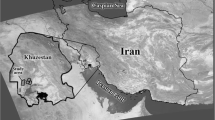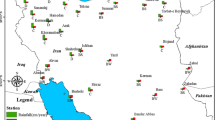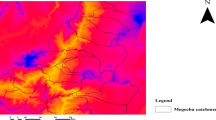Abstract
Most of the available models for reference evapotranspiration (ET0) estimation are based upon only an empirical equation for ET0. Thus, one of the main issues in ET0 estimation is the appropriate integration of time information and different empirical ET0 equations to determine ET0 and boost the precision. The FAO-56 Penman–Monteith, adjusted Hargreaves, Blaney–Criddle, Priestley–Taylor, and Jensen–Haise equations were utilized in this study for estimating ET0 for two stations of Belgrade and Nis in Serbia using collected data for the period of 1980 to 2010. Three-order tensor is used to capture three-way correlations among months, years, and ET0 information. Afterward, the latent correlations among ET0 parameters were found by the multiway analysis to enhance the quality of the prediction. The suggested method is valuable as it takes into account simultaneous relations between elements, boosts the prediction precision, and determines latent associations. Models are compared with respect to coefficient of determination (R 2), mean absolute error (MAE), and root-mean-square error (RMSE). The proposed tensor approach has a R 2 value of greater than 0.9 for all selected ET0 methods at both selected stations, which is acceptable for the ET0 prediction. RMSE is ranged between 0.247 and 0.485 mm day−1 at Nis station and between 0.277 and 0.451 mm day−1 at Belgrade station, while MAE is between 0.140 and 0.337 mm day−1 at Nis and between 0.208 and 0.360 mm day−1 at Belgrade station. The best performances are achieved by Priestley–Taylor model at Nis station (R 2 = 0.985, MAE = 0.140 mm day−1, RMSE = 0.247 mm day−1) and FAO-56 Penman–Monteith model at Belgrade station (MAE = 0.208 mm day−1, RMSE = 0.277 mm day−1, R 2 = 0.975).






Similar content being viewed by others
References
Acar E, Yener B (2009) Unsupervised multiway data analysis: a literature survey. IEEE Trans Knowl Data Eng 21(1):6–20
Allen, R. G., Pereira, L. S., Raes, D., Smith, M., 1998 Crop evapotranspiration. Guidelines for Computing Crop Water Requirements, FAO Irrigation and Drainage Paper 56, Roma, Italy
Berry M, Dumais S, O’Brien G (1995) Using linear algebra for intelligent information retrieval. SIAM Rev 37(4):573–595
Blaney HF, Criddle WD (1950) Determining water requirements in irrigated areas from climatological and irrigation data. Soil conservation service technical paper 96, soil conservation service. Washington, US Department of Agriculture
Bormann H (2011) Sensitivity analysis of 18 different potential evapotranspiration models to observed climatic change at German climate stations. Clim Chang 104:729–753
Carroll JD, Chang J (1970) Analysis of individual differences in multidimensional scaling via an n-way generalization of ‘Eckartâ Young’ decomposition. Psychometrika 35:283–319
Chaudhury A, Oseledets I, Ramachandran R (2014) A computationally efficient technique for the solution of multi-dimensional PBMs of granulation via tensor decomposition. Comput Chem Eng 61:234–244
Cichocki, A., Zdunek, R., Phan, A.H., Amari, S., 2009 Nonnegative matrix and tensor factorizations: applications to exploratory multi-way data analysis and blind source separation. John Wiley & Sons, pp. 500. doi:10.1002/9780470747278
Cong F, Lin Q-H, Kuang L-D, Gong X-F, Astikainen P, Ristaniemi T (2015) Tensor decomposition of EEG signals: a brief review. J Neurosci Methods 248:59–69
Correa FE, Oliveira MDB, Gama J, Corrêa PLP, Rady J (2016) Analyzing the behavior dynamics of grain price indexes using Tucker tensor decomposition and spatio-temporal trajectories. Comput Electron Agric 120:72–78
de Almeida ALF, Favier G (2013) Double Khatri–Rao space–time-frequency coding using semi-blind PARAFAC based receiver. IEEE Signal Process Lett 20:471–474
Doorenbos J, Pruitt WO (1977) Crop water requirements. FAO irrigation and drainage. Paper no. 24 (rev.). FAO, Rome
Douglas EM, Jacobs JM, Sumner DM, Ray RL (2009) A comparison of models for estimating potential evapotranspiration for Florida land cover types. J Hydrol 373:366–376
Favier G, Fernandes CAR, de Almeida ALF (2016) Nested Tucker tensor decomposition with application to MIMO relay systems using tensor space–time coding (TSTC). Signal Process 128:318–331
Fisher JB, DeBiase TA, Qi Y, Xu M, Goldstein AH (2005) Evapotranspiration models compared on a Sierra Nevada forest ecosystem. Environ Model Softw 20:783–796
Furnas, G., Deerwester, S., Dumais, S., 1988 Information retrieval using a singular value decomposition model of latent semantic structure. In the proceedings of the 11th annual international ACM SIGIR conference on Research and development in information retrieval
Guo T, Han L, He L, Yang X (2014) A GA-based feature selection and parameter optimization for linear support higher-order tensor machine. Neurocomputing 144:408–416
Harshman, R.A., 1970. Foundations of the PARAFAC procedure: models and conditions for an “explanatory” multi-modal factor analysis. In: UCLA working papers in phonetics, 1–84.
Hitchcock FL (1927) The expression of a tensor or a polyadic as a sum of products. J Math Phys 6(1):164–189
Jensen ME, Haise HR (1963) Estimating evapotranspiration from solar radiation. J Irrig Drain Eng 93:15–41
Jensen ME, Burman RD, Allen RG (1990) Evapotranspiration and irrigation water requirements. ASCE manuals and reports on engineering practice no.70. ASCE, New York
Katerji N, Rana G (2014) FAO-56 methodology for determining water requirement of irrigated crops: critical examination of the concepts, alternative proposals and validation in Mediterranean region. Theor Appl Climatol 116:515–536
Kolda T, Bader B (2009) Tensor decompositions and applications. SIAM Rev 51(3):455–500
Kolda, T. G., Sun, J., 2008 Scalable tensor decompositions for multi-aspect data mining. In the proceeding of the 8th IEEE International Conference on Data Mining (ICDM)
Kroonenberg PM (2008) Applied multiway data analysis. Wiley, New York 2008
Lathauwer LD, Moor BD, Vandewalle J (2000) A multilinear singular value decomposition. SIAM J Matrix Anal Appl 21(4):1253–1278
Lei J, Liu WY, Liu S, Wang XY (2015) Dynamic imaging method using the low n-rank tensor for electrical capacitance tomography. Flow Meas Instrum 41:104–114
Lu J, Sun G, McNulty SG, Amatya DM (2005) A comparison of six potential evapotranspiration methods for regional use in the southeatern United States. J Am Water Resour Assoc 41:621–633
Muti D, Bourennane S (2007) Survey on tensor signal algebraic filtering. Signal Process 87(2):237–249
Nanopoulos A (2011) Item recommendation in collaborative tagging systems. IEEE Trans Syst Man Cybern Part A: Syst Hum 41(4):760–771
Pereira LS, Allen RG, Smith M, Raes D (2015) Crop evapotranspiration estimation with FAO56: past and future. Agric Water Manag 147:4–20
Perera KC, Western AW, Nawarathna B, George B (2015) Comparison of hourly and daily reference crop evapotranspiration equations across seasons and climate zones in Australia. Agric Water Manag 148:84–96
Popova Z, Kercheva M, Pereira LS (2006) Validation of the FAO methodology for computing ETo with limited data: application to South Bulgaria. Irrig Drain 55:201–215
Priestley CHB, Taylor RJ (1972) On the assessment of surface heat flux and evaporation using large scale parameters. Mon Weather Rev 100:81–92
Qiao Y-N, Yong Q, Di H (2011) Tensor Field Model for higher-order information retrieval. J Syst Softw 84(12):2303–2313
Rahimikhoob A, Behbahani MR, Fakheri J (2012) An evaluation of four reference evapotranspiration models in a subtropical climate. Water Resour Manag 26:2867–2881
Rivington M, Bellocchi G, Matthews KB, Buchan K (2005) Evaluation of three model estimations of solar radiation at 24 UK stations. Agric For Meteorol 132:228–243
Sidiropoulos ND, Giannakis GB, Bro R (2000) Blind PARAFAC receivers for DSCDMA systems. IEEE Trans Signal Process 48:810–823
Smilde A, Bro R, Geladi P (2004) Multi-way analysis with applications in the chemical sciences. Wiley, New York
Sun M, Van Hamme H (2013) Joint training of non-negative Tucker decomposition and discrete density hidden Markov models. Comput Speech Lang 27(4):969–988
Sun, J., Shen, D., Zeng, H., Yang, Q., Lu, Y., Chen, Z., 2005 Cubesvd: A novel approach to personalized Web search. In the proceedings of the 14th international conference on World Wide Web
Sun, J., Tao, D., Faloutsos, C., 2006 Beyond streams and graphs: dynamic tensor analysis. In the proceedings of the 12th ACM SIGKDD international conference on knowledge discovery and data mining
Tabari H (2010) Evaluation of reference crop evapotranspiration equations in various climates. Water Resour Manag 24:2311–2337
Tabari H, Grismer ME, Trajkovic S (2013) Comparative analysis of 31 reference evapotranspiration methods under humid conditions. Irrig Sci 31(2):107–117
Tan H, Cheng B, Wang W, Zhang Y-J, Ran B (2014) Tensor completion via a multi-linear low-n-rank factorization model. Neurocomputing 133:161–169
Trajkovic S (2007) Hargreaves versus Penman–Monteith under humid conditions. J Irrig Drain Eng 133(1):38–42
Trajkovic S, Kolakovic S (2009) Wind-adjusted Turc equation for estimating reference evapotranspiration. Hydrol Res 40(1):45–52
Trajkovic S, Stankovic M, Todorovic B (2000) Estimation of FAO Blaney-Criddle b factor by RBF network. J Irrig Drain Eng 126(4):268–271
Tucker LR (1966) Some mathematical notes on three-mode factor analysis. Psychometrika 31(3):279–311
Utset A, Farre I, Martinez-Cob A, Cavero J (2004) Comparing Penman–Monteith and Priestley–Taylor approaches as referenceevapotranspiration inputs for modeling maize water-use under Mediterranean conditions. Agric Water Manag 66(3):205–219
Valiantzas JD (2013) Simplified forms for the standardized FAO-56 Penman-Monteith reference evapotranspiration using limited weather data. J Hydrol 505:13–23
Vanderlinden K, Giraldez JV, Van Meirvenne M (2004) Assessing reference evapotranspiration by the Hargreaves method in southern Spain. J Irrig Drain Eng 130(3):184–191
Wang H, Ahuja N (2008) A tensor approximation approach to dimensionality reduction. Int J Comput Vis 76(3):217–229
Wang L, Bai J, Wu J, Jeon G (2015) Hyperspectral image compression based on lapped transform and Tucker decomposition. Signal Process Image Commun 36:63–69
Wu Q, Zhang L, Cichocki A (2014) Multifactor sparse feature extraction using Convolutive Nonnegative Tucker Decomposition. Neurocomputing 129:17–24
Xystrakis F, Matzarakis A (2010) Evaluation of 13 empirical reference potential evapotranspiration equations on the island of Crete in southern Greece. J Irrig Drain Eng 137:211–222
Acknowledgments
The study was supported by ICT COST Action IC1408 Computationally-intensive methods for the robust analysis of non-standard data (CRoNoS) and the Ministry of Education, Science and Technological Development, Republic of Serbia (Grant No. TR37003).
Author information
Authors and Affiliations
Corresponding author
Rights and permissions
About this article
Cite this article
Misaghian, N., Shamshirband, S., Petković, D. et al. Predicting the reference evapotranspiration based on tensor decomposition. Theor Appl Climatol 130, 1099–1109 (2017). https://doi.org/10.1007/s00704-016-1943-2
Received:
Accepted:
Published:
Issue Date:
DOI: https://doi.org/10.1007/s00704-016-1943-2




